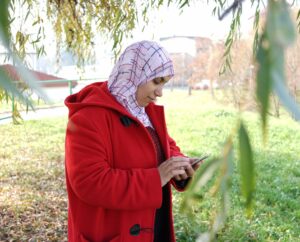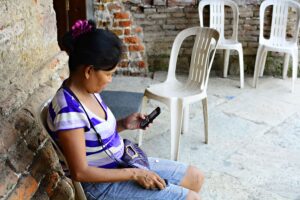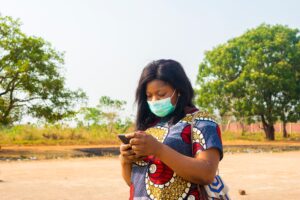Six Insights from the 2021 World Bank Global Findex Data
By Sonja Kelly, Director of Research & Advocacy
For those of us in the financial inclusion world, the release of the Global Findex is a pivotal moment. The data are typically compiled every three years – this time, due to Covid, it was four — providing us with the evidence that will drive business decisions, government policies and strategic choices until the next release.
Here are six insights we are incorporating into our own work:

1. Fewer women are excluded from formal financial services, but there is much work ahead.
While around 250 million more women in developing countries finally have some form of financial access, three times that many, roughly three quarters of a billion women, are still excluded for absolutely no good reason, and so we still have a lot of work to do. That’s 742 million women – if that were a country, it would be the third largest in the world. We still have work to do as these remaining women will be the most difficult to reach—these are the poorest, in rural areas, least educated, without connectivity, with limited to no access to a mobile phone.
2. The new gender gap at 6 percentage points is nuanced.
The gender gap in account ownership in emerging markets, down from 9%, does not sufficiently reflect the situation in many countries where women are still not given the same opportunity as men to participate in, and benefit from, economic growth. While India’s gender gap has fallen 17 percentage points in the last decade (in part due to closure of dormant accounts, many of which were held by men), Benin’s has risen the same amount. Bangladesh and Nigeria both show a 20 percentage point gap, Pakistan still has a 15 percentage point gap, and Tanzania shows a 13 percentage point gap. The gap isn’t going to close itself—progress of 3 percentage points over a decade has taken enormous resources as well as a disruptive global pandemic driving digitization and account opening through G2P payments. This brings us to…

3. Digital payments during Covid-19 drove women’s financial inclusion.
Women and men were equally likely to open accounts to send and receive digital payments during Covid-19. Evidence supports that government-to-person payments were an equal opportunity force for inclusion, with men and women equally likely to open an account to receive a government payment. During Covid-19, men and women were equally likely to pay utilities or make a merchant payment for the first time. There is strong evidence that payments drive usage of other services for men and women—the World Bank team reports that receiving a payment can usher in active use of an account, build a digital footprint on which to access credit, and acquire insurance alongside of these products. This evidence also points to an opportunity, as 40 million women still receive government-to-person digital payments in cash.
4. Proliferation of enabling technologies has slowed.
Covid-driven digital usage, especially payments, may have accelerated inclusion in the short term, but unequal access to technology opens up longer term risks of exclusion. It also remains unclear what the future will hold now that the drivers of technology and digital finance adoption—namely pandemic-related restrictions and government support payments related to Covid-19—have waned. We know from GSMA data that among smartphone ownership – the gender gap has widened – it is now 18%, up from 15% in 2021, translating to 315 million fewer women than men owning a smartphone. Similarly, while the mobile internet gender gap had been reducing, progress has stalled. Women are now 16% (up 1%) less likely than men to use mobile internet, which translates into 264 million fewer women than men using mobile internet. When the data collection team fielding the Findex survey asked women without mobile accounts why they remained outside the financial system, they cited mobile phone ownership and lack of ID as drivers of their lack of participation, among other reasons.
 5. There is new evidence to guide a “women-centered design” approach.
5. There is new evidence to guide a “women-centered design” approach.
Women’s World Banking is consistently incorporating insights on women’s unique needs, preferences, and behaviors into the products it works with financial services providers to design. The Global Findex gives us new evidence for this approach. For example:
- Globally, women are 31% more likely to have an inactive account than men.
- 35% of women in emerging markets store money in accounts compared to 43% of men, an 8 percentage point gap in use of accounts for saving.
- In emerging markets, unbanked women are 25% less likely than men to say they could use an account self-sufficiently.
Focusing on building women’s digital financial capability, increasing nudges to drive account activation, and building women’s savings habits will all work to increase their inclusion.
6. Access is progress, but usage is not guaranteed.
The financial services industry has moved quickly on access, spurred on by commitments like Universal Financial Access at the World Bank. But usage has not followed apace. A quarter billion women who have an account admit that they have not used it for the past year. Only if financial services are used will women be able to use these tools for their economic engagement and empowerment. Women’s World Banking measures the material, cognitive, perceptual, and relational outcomes associated with active use of services, showing that not all financial services are designed for life change. There is tremendous room for growth in this area, as women are less likely to be financially resilient than men are.
Take action with us to economically empower women as we continue design, scale, and invest in policy, product, and people. Progress is happening, and together we can move the needle on women’s financial inclusion to ensure women’s access to and use of financial services can help them pursue their goals.



